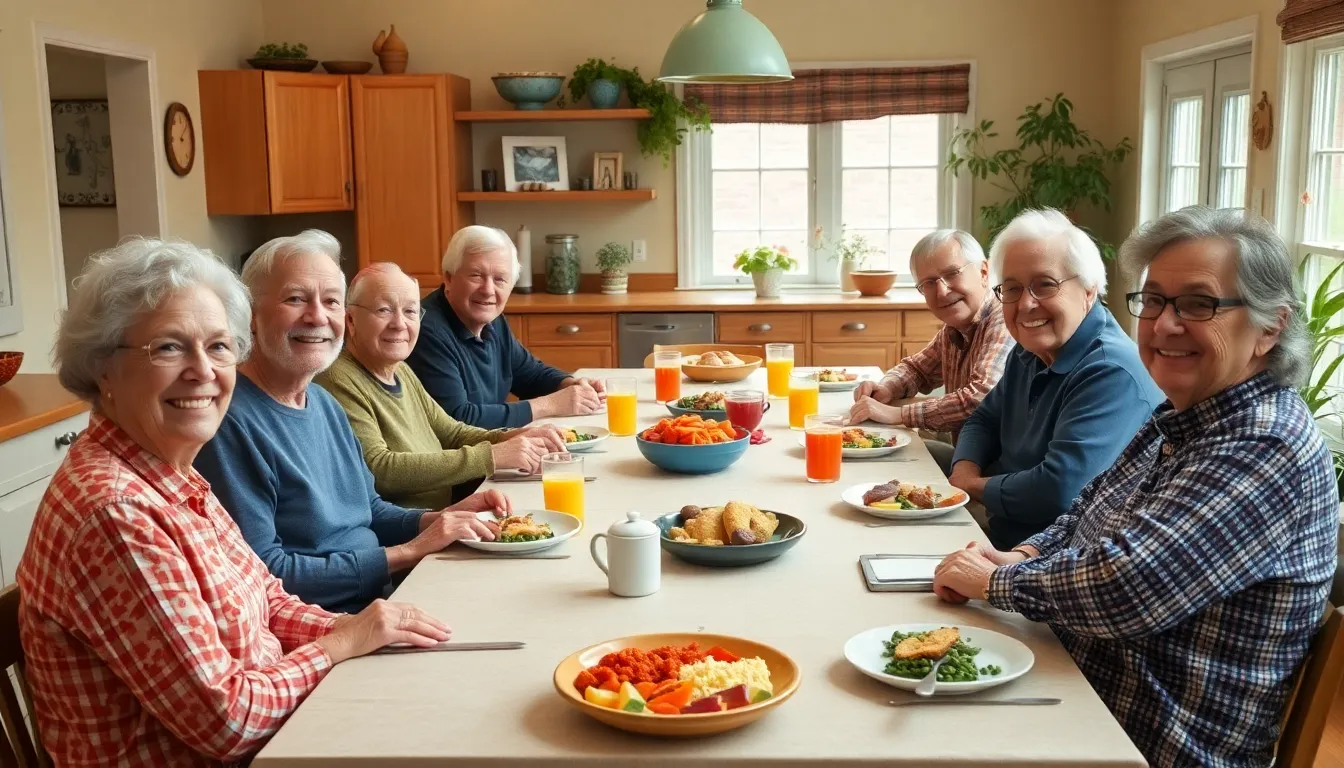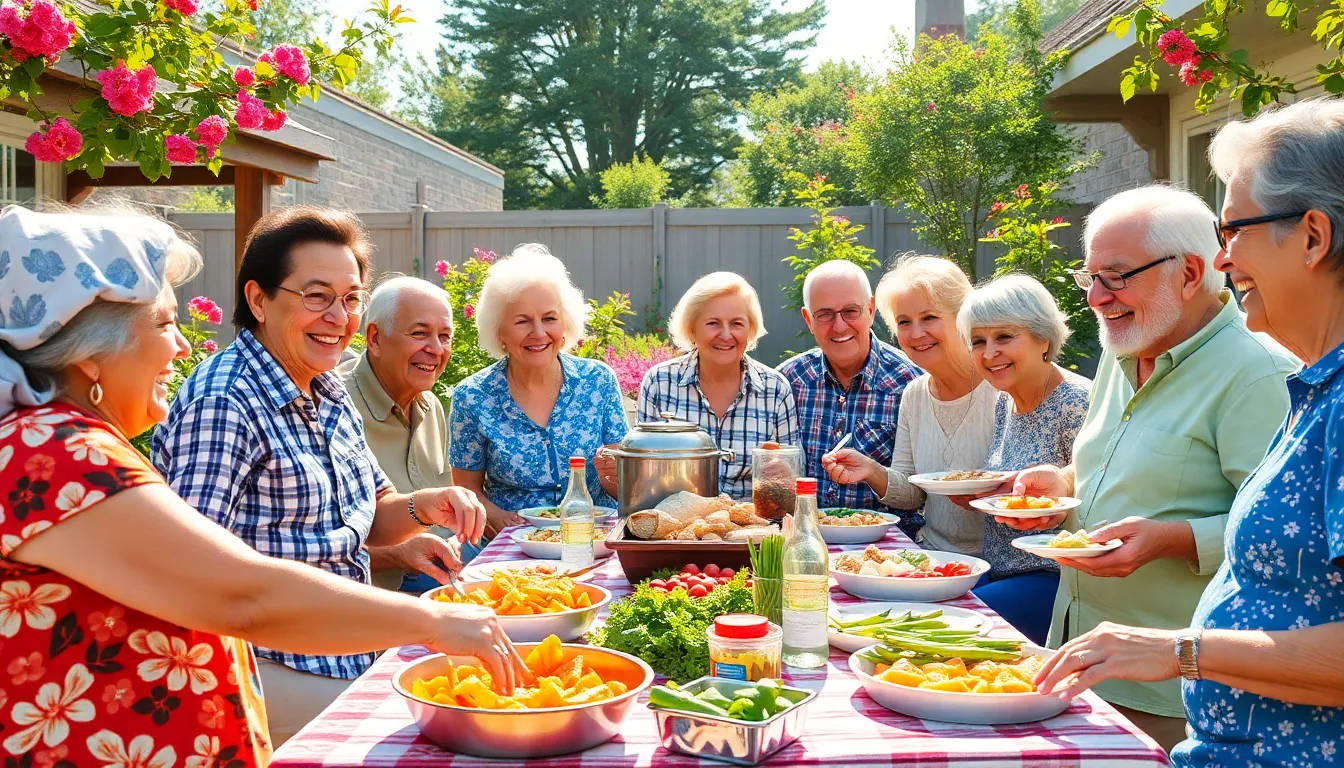Imagine a vibrant community where seniors thrive, share laughter, and enjoy life to the fullest. Senior cohousing isn’t just about living together; it’s about creating a supportive family of friends who understand the joys (and occasional quirks) of aging. Gone are the days of isolation—welcome to a new era where neighbors become confidants and every day feels like a social event.
In this unique living arrangement, seniors can embrace independence while having a built-in support system. Picture potlucks, book clubs, and spontaneous game nights—all without the hassle of planning a solo party. With senior cohousing, it’s not just about sharing a roof; it’s about sharing experiences, wisdom, and plenty of laughs. So, let’s dive into the world of senior cohousing and discover how it’s redefining what it means to age gracefully and joyfully.
Table of Contents
ToggleOverview of Senior Cohousing
Senior cohousing creates communities where older adults live independently but connect within a supportive environment. Residents design their shared spaces with communal areas that facilitate interaction and cooperation. Cohousing arrangements often include private homes alongside common facilities such as kitchens, gardens, and activity rooms.
Social engagement plays a critical role in the success of senior cohousing. Activities like potlucks, movie nights, and group exercises strengthen friendships and foster a sense of belonging. Shared responsibilities, such as maintaining the communal garden or organizing events, enhance collaboration among residents.
Cohousing addresses the issue of isolation by promoting regular social interactions. Living in close proximity, seniors support one another emotionally and physically. These relationships provide a safety net, reducing the feelings of loneliness often experienced in traditional living situations.
Financial aspects of senior cohousing also present advantages. Pooling resources can lower living costs while providing access to shared amenities. This arrangement allows seniors to maintain their autonomy while benefiting from the collaborative nature of their community.
In urban and rural settings, senior cohousing options vary. Some environments cater to active lifestyles, offering fitness classes and excursions, while others focus on tranquility and nature. Each community tailors its offerings to meet the needs and desires of its residents, creating a diverse range of experiences.
Overall, senior cohousing nurtures a fulfilling living arrangement that combines independence with community support. It transforms the aging experience, allowing seniors to thrive collaboratively while engaging in a vibrant social life.
Benefits of Senior Cohousing


Senior cohousing offers numerous advantages that enhance the quality of life for older adults.
Community and Social Interaction
Strong community connections develop through shared activities. Potlucks, game nights, and group exercises foster friendships among residents. Engaging in collective experiences combats loneliness while promoting emotional well-being. Residents enjoy communal spaces designed specifically for interaction. Each gathering builds relationships and a support network, essential for combating isolation. Living in a setting that encourages social engagement positively impacts mental health.
Shared Resources and Costs
Pooling resources significantly lowers living costs for seniors. Shared amenities like kitchens, gardens, and activity rooms reduce individual expenses while enhancing the living experience. Economical living arrangements allow for budget-friendly options, ensuring access to necessary services. Residents often find that cooperative efforts lead to better maintenance of shared spaces. Financial stability gained through shared responsibilities promotes independence. This arrangement also encourages residents to collaborate, maximizing their resources effectively.
Challenges of Senior Cohousing
Senior cohousing presents unique challenges that require careful consideration and proactive solutions. Residents must navigate complex group dynamics and address various legal and financial aspects.
Navigating Group Dynamics
Managing group dynamics poses significant challenges. Conflicts may arise from differences in personalities, beliefs, and lifestyles. Open communication plays a key role in resolving misunderstandings. Establishing clear decision-making processes can ease tensions. Regular meetings foster transparency and encourage participation, allowing everyone to voice opinions. The collaborative nature of cohousing means residents must find common ground while respecting individual needs. Activities aimed at building trust, such as team-building exercises, can strengthen relationships and promote a cooperative atmosphere.
Legal and Financial Considerations
Legal and financial considerations are crucial for senior cohousing success. Establishing a solid governance structure ensures clear guidelines for community decisions. Understanding property ownership models, such as condominium or cooperative options, remains essential. Residents must also discuss ongoing maintenance costs and shared expenses upfront to avoid future disputes. Setting up a fund for emergencies or unexpected repairs provides financial security. Consulting legal experts specializing in real estate and senior housing can guide residents on regulatory compliance and contract details. Overall, addressing these factors helps create a stable living environment conducive to harmonious community living.
Examples of Successful Senior Cohousing Communities
Several senior cohousing communities exemplify the benefits and vibrancy of this living arrangement.
- EcoVillage, Ithaca, New York: This community features 100 households focused on sustainability and social connection. Residents participate in community dinners and work collaboratively on shared gardens.
- The Cohousing Community of Boulder, Colorado: With 28 homes, this community fosters a sense of connection through shared meals and events. Its design emphasizes open spaces that encourage interaction among residents.
- Cohousing at Pacifica, San Francisco, California: This community consists of 40 units designed for seniors seeking an active lifestyle. Residents enjoy social activities like yoga classes and potlucks, promoting deep connections.
- Heron’s Nest, Portland, Oregon: Ten homes make up this intimate community centered around creativity and support. It features art classes and community gardens that engage residents together.
- Cohousing in Seattle, Washington: A vibrant community with 34 units encourages collaboration through shared meals and organized events. It emphasizes inclusivity and participation in neighborhood decisions.
- Sagewood, Phoenix, Arizona: This multifaceted community provides a mix of independent living and assisted facilities. Residents engage in physical activities, workshops, and communal celebrations, enhancing their collective well-being.
Each of these examples illustrates how senior cohousing can create supportive environments where residents enjoy both independence and companionship. Regular social interactions are crucial in these communities, fostering friendships and a strong sense of belonging. Effective governance structures and open communication also contribute to their overall success, ensuring that everyone feels heard and valued.
Future Trends in Senior Cohousing
Demographic shifts indicate rising demand for senior cohousing. As the population of older adults continues to grow, these communities will diversify in design and amenities. Customizable living spaces are likely to become a prominent feature, allowing residents to tailor their homes to personal needs and preferences.
Technology integration will play a significant role in upcoming cohousing developments. Smart home features will enhance convenience and security, providing seniors with user-friendly systems for managing daily tasks. Health monitoring devices may also be incorporated, promoting wellness and allowing for proactive care within the community.
Sustainable practices are expected to gain traction in senior cohousing. Eco-friendly building materials and energy-efficient designs will become standard as communities strive to reduce their environmental footprint. Shared gardens and renewable energy sources, such as solar power, reflect this commitment to sustainability, encouraging residents to engage in environmentally responsible practices.
Community programming will evolve to foster deeper social connections among residents. Specific focus on intergenerational activities might enrich the environment, drawing in younger volunteers and family members to bridge generational gaps. Regular events that cater to diverse interests, from arts and crafts to technology workshops, will keep residents active and engaged.
Mobility and transportation options will become more integral to senior cohousing. Access to convenient public transportation and shared mobility services can enhance residents’ independence while reducing isolation. Collaborations with local organizations may yield resources supporting residents’ mobility needs, ensuring they remain connected to the broader community.
Ultimately, these trends demonstrate a shift towards more inclusive and sustainable living environments, where seniors can thrive in supportive communities that cater to their evolving needs.
Senior cohousing represents a transformative approach to aging that prioritizes community and connection. By fostering supportive environments where older adults can thrive together, these communities combat isolation and promote emotional well-being. The blend of private homes and shared spaces not only encourages social interactions but also enhances financial stability through resource pooling.
As trends evolve towards customizable living and sustainable practices, the future of senior cohousing looks promising. With a focus on technology and intergenerational activities, these vibrant communities are poised to meet the diverse needs of seniors. Ultimately, senior cohousing offers a pathway to a fulfilling and enriched lifestyle, ensuring that aging is not just about growing older but about enjoying life to the fullest.



